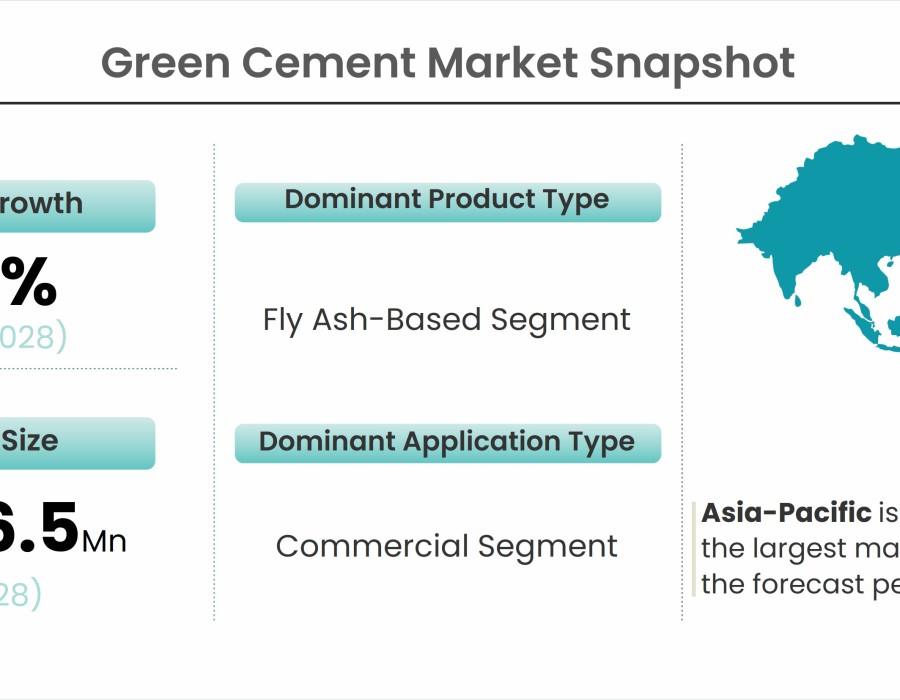Introduction
In an era defined by environmental consciousness and sustainable practices, industries across the board are seeking innovative ways to reduce their carbon footprint. Among these, the construction sector, notorious for its environmental impact, has seen a remarkable shift towards more eco-friendly practices. Central to this transformation is the emergence of green cement, a revolutionary alternative to traditional Portland cement. In this article, we'll explore what green cement is, its environmental benefits, and how it's reshaping the construction industry.
According to Stratview Research, the Global Green Cement Market is estimated to grow from US$ 699.31 Million in 2021 to US$ 1016.5 Million by 2028 at a CAGR of 5.4% during the forecast period of 2022-2028.
Green cement is a cementitious material, that meets or exceeds the functional performance capabilities of ordinary Portland cement by incorporating and improving recycled materials, thereby reducing the consumption of water and natural raw materials resulting in a more sustainable construction material.
Green cement is of different types, such as fly ash-based, slag-based, recycled aggregates, and others which provide its service in various applications, such as residential, commercial, and others.
To read more, click here: https://www.stratviewresearch.com/1370/green-cement-market.html
The Green Cement Revolution
Green cement, often referred to as sustainable or eco-friendly cement, is a breakthrough in construction materials. Unlike conventional Portland cement, which is produced through energy-intensive processes that release significant carbon dioxide emissions, green cement is manufactured using alternative materials and processes that greatly reduce its environmental impact.
- Reducing Carbon Footprint: One of the most significant advantages of green cement is its dramatically lower carbon footprint. Conventional cement production accounts for approximately 8% of global CO2 emissions. In contrast, green cement can achieve up to 80% reduction in CO2 emissions, making it a game-changer in the fight against climate change.
- Innovative Raw Materials: Green cement incorporates innovative raw materials like fly ash, slag, and natural pozzolans, which can be by-products of other industries. By utilizing these materials, green cement not only minimizes waste but also reduces the need for extracting virgin resources.
- Energy-Efficient Production: Unlike the energy-intensive process of clinker production in traditional cement manufacturing, green cement can be produced using more energy-efficient methods. This results in a substantial reduction in energy consumption during production.
- Durability and Performance: Contrary to the misconception that eco-friendly options compromise on performance, green cement often boasts enhanced durability and strength properties. This makes it an attractive choice for a wide range of construction applications.
Applications of Green Cement
Green cement is versatile and can be used in various construction projects, from residential buildings to large-scale infrastructure developments. Its applications include:
- Residential Construction: Green cement is an excellent choice for residential buildings, offering homeowners a sustainable and durable option for their homes.
- Commercial Buildings: Many commercial projects now prioritize the use of green materials, aligning with corporate sustainability goals and attracting environmentally conscious tenants.
- Infrastructure Projects: Bridges, roads, and other critical infrastructure can benefit from the reduced environmental impact and enhanced performance of green cement.
- Institutional Buildings: Schools, hospitals, and government buildings are increasingly incorporating green cement into their construction projects, aligning with public demand for sustainable practices.
- Renovation and Retrofitting: Existing structures can also benefit from the application of green cement, providing an opportunity to reduce their environmental impact and improve longevity.
The Road Ahead
As the demand for sustainable construction practices continues to rise, the green cement market is poised for exponential growth. Major players in the construction industry, along with governments and regulatory bodies, are recognizing the importance of adopting eco-friendly materials.
Moreover, ongoing research and development in the field of green cement promise even more advanced formulations and production techniques. This continuous innovation will further drive down the environmental impact of construction materials and contribute to a more sustainable future.
Conclusion
The rise of green cement marks a pivotal moment in the construction industry's journey towards sustainability. By significantly reducing carbon emissions, utilizing innovative raw materials, and enhancing performance, green cement is revolutionizing the way we build. As its adoption continues to grow, we can look forward to a future where construction is not only efficient and durable but also deeply conscious of its environmental responsibilities. Embracing green cement is not just a choice; it's a commitment to a more sustainable and resilient world.
About Us
Stratview Research is a global market research firm, offering syndicated and custom research reports along with growth consulting services. Our business intelligence and industry research reports offer clients insightful market data to aid strategic decision-making. These exclusive reports are the result of exclusive research methodology and are available for key industries such as chemicals, composites, advanced materials, technology, renewable energy, and more.
Stratview Research delivers custom research services across sectors. In case of any custom research requirements, please send your inquiry to [email protected] or connect with our experts at +1-313-307-4176.





Comments